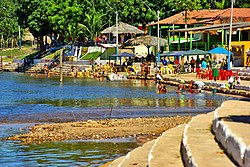Balsas (Portuguese pronunciation: [ˈbawsɐs]) is a city in the state of Maranhão, northeast Brazil. It is located in southern Maranhão, 800 km from the capital of the state, São Luís.
Balsas | |
|---|---|
Municipality | |
| The Municipality of Balsas | |
 The Das Balsas River, a popular tourist attraction in Balsas | |
| Nicknames: "Bls", "Balsinhas de Açúcar", "Princesinha do Sul do Maranhão", "Capital da Agricultura e da Lavoura Mecanizada" ("Bls", "Little Sugar Ferries", "Little Princess of Southern Maranhão", "Capital of the Mechanized Agriculture") | |
 Location of Balsas in the State of Maranhão | |
| Coordinates: 07°31′38″S 46°02′39″W / 7.52722°S 46.04417°W | |
| Country | Brazil |
| Region | Northeast |
| State | Maranhão |
| Founded | March 22, 1918 |
| Government | |
| • Mayor | Erik Augusto Costa e SilvaPDT) |
| Area | |
• Total | 13,141.637 km2 (5,074.014 sq mi) |
| [1] | |
| Elevation | 283 m (928 ft) |
| Population (2022 [2]) | |
• Total | 107,767 |
| • Density | 8.2/km2 (21/sq mi) |
| Time zone | UTC−3 (BRT) |
| HDI (2000) | 0.696 – medium[3] |
| Website | www.balsas.ma.gov.br |
Geography
editBalsas covers an area of 13,141.64 km2, being the largest municipality in Maranhão. The median elevation of the city is 283 meters (810 ft).
Climate
editBalsas has a Savanna tropical climate. Temperature is hot from April through October. It rains from November through March.
| Climate data for Balsas (1981–2010) | |||||||||||||
|---|---|---|---|---|---|---|---|---|---|---|---|---|---|
| Month | Jan | Feb | Mar | Apr | May | Jun | Jul | Aug | Sep | Oct | Nov | Dec | Year |
| Mean daily maximum °C (°F) | 31.0 (87.8) |
31.2 (88.2) |
31.2 (88.2) |
31.6 (88.9) |
32.4 (90.3) |
32.9 (91.2) |
33.3 (91.9) |
34.8 (94.6) |
35.4 (95.7) |
33.9 (93.0) |
32.2 (90.0) |
31.0 (87.8) |
32.6 (90.7) |
| Daily mean °C (°F) | 25.8 (78.4) |
25.9 (78.6) |
25.9 (78.6) |
26.4 (79.5) |
26.6 (79.9) |
26.3 (79.3) |
26.2 (79.2) |
27.5 (81.5) |
28.8 (83.8) |
28.1 (82.6) |
26.8 (80.2) |
26.0 (78.8) |
26.7 (80.1) |
| Mean daily minimum °C (°F) | 21.9 (71.4) |
22.0 (71.6) |
22.2 (72.0) |
22.5 (72.5) |
21.8 (71.2) |
20.4 (68.7) |
19.4 (66.9) |
20.2 (68.4) |
22.2 (72.0) |
22.8 (73.0) |
22.3 (72.1) |
22.0 (71.6) |
21.6 (70.9) |
| Average precipitation mm (inches) | 195.9 (7.71) |
178.9 (7.04) |
206.0 (8.11) |
134.8 (5.31) |
46.0 (1.81) |
4.0 (0.16) |
2.3 (0.09) |
4.2 (0.17) |
27.6 (1.09) |
98.0 (3.86) |
133.1 (5.24) |
201.7 (7.94) |
1,232.5 (48.52) |
| Average precipitation days (≥ 1.0 mm) | 12 | 12 | 14 | 11 | 4 | 1 | 0 | 1 | 2 | 7 | 9 | 12 | 85 |
| Average relative humidity (%) | 80.5 | 80.4 | 80.9 | 78.0 | 71.4 | 61.4 | 52.7 | 47.9 | 49.5 | 62.5 | 73.6 | 79.1 | 68.2 |
| Mean monthly sunshine hours | 148.9 | 137.4 | 154.9 | 184.9 | 238.8 | 268.5 | 289.1 | 294.4 | 254.0 | 191.5 | 149.6 | 132.0 | 2,444 |
| Source: Instituto Nacional de Meteorologia[4] | |||||||||||||
Vegetation
editCerrado is the typical vegetation of the area. However, due to the advance of agricultural activities, the ecosystems is threatened.
Hydrography
editThere are many streams and rivers in the municipality, but the most important is Rio Balsas, which crosses the city.
Demographics
editAccording to 2001 census, Balsas has 60,613 inhabitants. 82.73% live in Urban areas. The infant mortality rate is 35.1 deaths /1,000 live births and life expectancy is 64.1 years.
The annual median growth of the population is 4.21%. In 2007 the population was over 78,000 inhabitants. The city is the seat of the Roman Catholic Diocese of Balsas.
Notable people
edit- Manoel Gomes, singer
References
edit- ^ IBGE - "Archived copy". Archived from the original on January 9, 2007. Retrieved August 3, 2014.
{{cite web}}: CS1 maint: archived copy as title (link) - ^ IBGE 2022
- ^ "Archived copy". Archived from the original on 2009-10-03. Retrieved 2009-12-17.
{{cite web}}: CS1 maint: archived copy as title (link) UNDP - ^ "Normais Climatológicas Do Brasil 1981–2010" (in Portuguese). Instituto Nacional de Meteorologia. Retrieved 21 May 2024.

